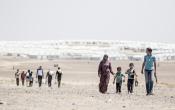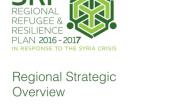Iraq
Operation: Iraq
Location
{"longitude":43,"latitude":33,"zoom_level":0}
Latest update of camps and office locations 21 Nov 2016. By clicking on the icons on the map, additional information is displayed.
Key Figures
| 2018 planning figures | |
| 200,000 | IDP and returnee families will receive core relief items |
| 120,000 | IDP and returnee families will receive cash grants |
| 115,000 | IDPs and returnees will receive legal assistance |
| 21,000 | Syrian refugee families will receive core relief items |
| 27,500 | Syrian refugees will receive legal assistance |
| 16,000 | Syrian refugee families will receive cash grants |
| 2016 end-year results | |
| 231,000 | registered Syrian refugees |
| 89,000 | internally displaced families received core relief items and 25,000 internally displaced families received winter asssistance |
| 53,000 | IDPs and 9,900 Syrian refugees received legal assistance |
| 29,000 | emergency shelters were provided to IDPs |
| 24,000 | Syrian refugee families received core relief items and 28,624 Syrian refugee families received winter assistance |
| 18,000 | internaly displaced families and 10,000 Syrian refugee families received cash grants |
| 11 | camps were built in 2016 as part of emergency preparedness for displacement from Mosul and surrounding areas |
Latest Updates and Related Links
as of 25 September 2017
People of Concern
12%
Increase in
2016
2016
| 2016 | 5,326,166 |
| 2015 | 4,746,105 |
| 2014 | 4,026,863 |

[["Refugees",261888],["Asylum-seekers",11458],["IDPs",3604285],["Returned IDPs",1397016],["Returned refugees",157],["Stateless",48200],["Others of concern",3162]]
Loading ...
Iraq
< Back
2016
{"categories":[2013,2014,2015,2016,2017,2018],"budget":[293.72933672,564.26129787,556.06492208,546.94595405,557.09376087,559.826116846],"expenditure":[188.35476498,311.98260697,266.34543259,338.02568545,null,null]}
{"categories":[2013,2014,2015,2016,2017,2018],"p1":[182.85293216,162.76932396,136.09662109,116.48767369,137.52939031,135.891730749],"p2":[1.32216338,2.00000074,2.0459884,0.80424081,0.623739,0.307821],"p3":[27.30414868,39.59885527,35.76378805,26.70785472,null,null],"p4":[82.2500925,359.8931179,382.15852454,402.94618483,418.94063156,423.626565097]}
{"categories":[2013,2014,2015,2016,2017,2018],"p1":[131.81378143,109.08450058,102.03521415,98.77158239,null,null],"p2":[0.42206457,1.96887166,1.499491,0.30823717,null,null],"p3":[14.49497183,10.53576239,11.32961956,1.89021959,null,null],"p4":[41.62394715,190.39347234,151.48110788,237.0556463,null,null]}
Loading ...
CHOOSE A YEAR
- 2014
- 2015
- 2016
- 2017
- 2018
Year-end Overview
Working environment
Since January 2014, the escalating violence in Iraq has led to the internal displacement of more than 3.2 million people. In addition, there are approximately one million IDPs displaced between 2006 and 2007. The military operations against extremist groups are expected to be drawing to a close, which will improve security and accelerate IDP returns. Humanitarian access is expected to expand in most areas of the country. The effects of the economic crisis and the asymmetrical attacks in newly retaken areas will continue to impact the protection environment for displaced and host communities. In 2018, efforts will increasingly focus on the most vulnerable, while care and maintenance assistance will gradually be phased out. The refugee population in Iraq is expected to remain largely stable.
UNHCR’s expects to continue key partnerships with government authorities and explore all viable options to transition out of humanitarian interventions and pursue the systematic inclusion of people of concern into national development plans and the programmes of development-oriented UN agencies. UNHCR will continue to lead the Protection, Camp Coordination and Camp Management (CCCM), and Shelter/Non-Food items clusters, as part of the cluster coordination mechanism for IDP response, and lead the humanitarian response for Syrian refugees in coordination with the authorities through the Regional Refugee and Resilience Plan (3RP).
Key priorities
In 2018, UNHCR will focus on:
- Providing in-kind and cash-based assistance to the most vulnerable people and providing shelter to IDPs. Further enhancing the protection space as well as advocating and promoting access to asylum procedures;
- Exploring all viable options to transition out of humanitarian interventions and pursue the systematic inclusion of people of concern into national development plans and the programmes of development-oriented UN agencies;
- Ensuring adequate shelter through prioritizing construction and repair of shelters for the most vulnerable IDP families;
- Providing together with protection partners free legal services for those in displacement and in areas of return across Iraq;
- Mainstreaming sexual and gender-based violence (SGBV) response programmes into non-food item, shelter, and camp management activities, increasing monitoring and access to quality services across Iraq.
- Advocating with the Government to develop a national legal framework for refugee protection and provide technical support to the authorities to enhance the protection environment for Syrian and non-Syrian refugees and asylum-seekers.







